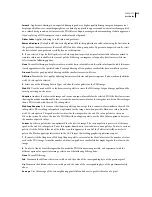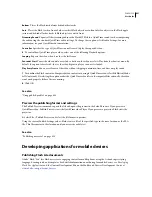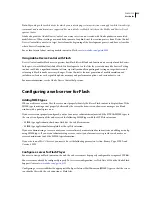
FLASH CS3
User Guide
432
Note:
Depending on the mobile device for which you are developing, certain restrictions can apply to which ActionScript
commands and sound formats are supported. For more details, see Mobile Articles on the Mobile and Devices Devel-
opment Center.
Adobe also provides Adobe Device Central, a new way to test content created with Adobe products on emulated
mobile devices. When creating a new mobile document of any kind, start the creation process from Device Central.
Device Central lets you select a target device from the beginning of the development process, and have a clear idea
what a device’s limitations are.
For a video tutorial about creating mobile content in Flash, see
www.adobe.com/go/vid0206
.
Using Adobe Device Central with Flash
Device Central enables Flash users to preview how Flash files will look and function on a variety of mobile devices.
In the past, it was difficult for Adobe Flash Lite developers to test the files they created on mobile devices. Testing
content could take a significant amount of time, especially manually exporting and testing on target devices and
returning to Flash to make necessary changes. Device Central is the next generation of mobile emulation and
includes new features such as profile updates, memory and performance options, and custom device sets.
For more information, see the Adobe Device Central help system.
Configuring a web server for Flash
Adding MIME types
When a web server accesses files, the server must properly identify the files as Flash content to display them. If the
MIME type is missing or not properly delivered by the server, the browser can show error messages or a blank
window with a puzzle-piece icon.
If your server is not properly configured, you (or your server’s administrator) must add the SWF file MIME types to
the server’s configuration files and associate the following MIME types with the SWF file extensions:
•
MIME type application/x-shockwave-flash has the .swf file extension.
•
MIME type application/futuresplash has the .spl file extension.
If you are administering a server, consult your server software documentation for instructions on adding or config-
uring MIME types. If you are not administering a server, contact your Internet service provider, web master, or
server administrator to add the MIME type information.
If your site is on a MAC OS server, you must also set the following parameters: Action: Binary; Type: SWFL; and
Creator: SWF2.
Configure a server for Flash Player
For users to view your Flash content on the web, the web server must be properly configured to recognize SWF files.
Your server may already be configured properly. To test server configuration, see TechNote 4151 on the Adobe Flash
Support Center at
www.adobe.com/go/tn_4151
.
Configuring a server establishes the appropriate Multipart Internet Mail Extension (MIME) types so that the server
can identify files with the .swf extension as Flash files.
















































